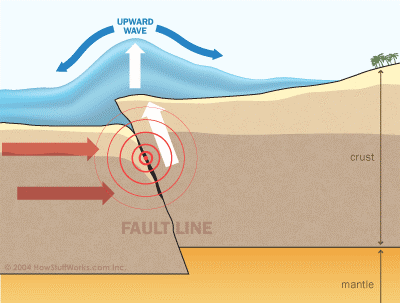A seaquake can cause a tsunami or a giant wave that sweeps the ocean and sometimes devastates the coastline. The word 'tsunami' is Japanese, meaning 'port wave'. It is called the wave port because the power to destroy it is only visible when the wave has reached the beach- or port. These waves are also known as seismic sea waves. Sometimes, tsunamis are also called tidal waves. However, this mention is misleading because it has nothing to do with tidewater.
Image source

Causes of the Tsunami
Causes of a Tsunami
A tsunami is caused by seismic waves from a seaquake (an underwater earthquake) that shakes the ocean floor then shakes the water above it. In the open ocean, tsunami waves move very fast. About three-quarters of all devastating tsunamis occur in the Pacific Ocean. Because of it's Pacific central location, Hawaii became the ideal place for the Pacific Tsunami Warning Center. After the tsunami of 26 December 2004 occurred, Tsunami Disaster and Mitigation Research Center was founded in Aceh. Information learned by earlier tsunami research will provide knowledge and opportunities for the population to reduce the disaster risks.
Image source

Tsunami-Like Jet
Tsunami can travel through the ocean at speeds of up to 800 kilometers/hour, just as fast as a jet plane. As the waves approach the shore, tsunamis move more slowly, but vertically can soar very high. Tsunami waves can reach a height of 30 meters or more. The power of these waves is able to undermine buildings and drag boats, ships, large boulders, and any variety of material to the mainland.
Image source

Tsunami Aceh, 26 December 2004
The tsunami that occurred in Aceh on December 26, 2004, is one of the most deadly natural disasters ever recorded in history. The disaster that devastated Aceh originated from the seabed of the Indian Ocean and reached northwest of Sumatera, where two tectonic plates meet. This occurred because one of the plates thrusted under the other one, producing large amounts of voltage due to the fault line suddenly jolting and thus triggered a massive earthquake. As a result, the seabed rapidly lifted 20 meters, moving billions of tonnes of seawater. Over 300,000 people died in this event, with many human bodies disappearing without being rediscovered.
The Tsunami Concept
Feet dipped abruptly in a pool or a rock dropped into a pond produces a widening circle of waves. Much the same way, earthquakes that occur under the seabed create a series of waves that can propagate thousands of kilometers and produce waves. This is called a tsunami.
Mangrove Forest
Mangrove forests grow in brackish water and are affected by tides. Mangrove ecosystems are uniquely characteristic because of puddling which results in a lack of soil abrasion and erosion.
A very important benefit of mangrove forests is the ecological function as a protector of the coastline. One of the main functions of mangroves is to protect the coastline from abrasion, as well as to reduce large waves- including tsunamis. Because mangrove forests have strong roots they act as a break against incoming waves. In Japan, one effort to reduce the impact of the tsunami threat is to build a green belt of mangrove forest along the coastline. In Indonesia, there are some areas that are categorized as prone to tsunamis because the forest has changed many functions into ponds.
Source:
- id.Wikipedia
- Adriansyah, Faizal, 2012, Aceh Laboratorium Bencana, Banda Aceh


